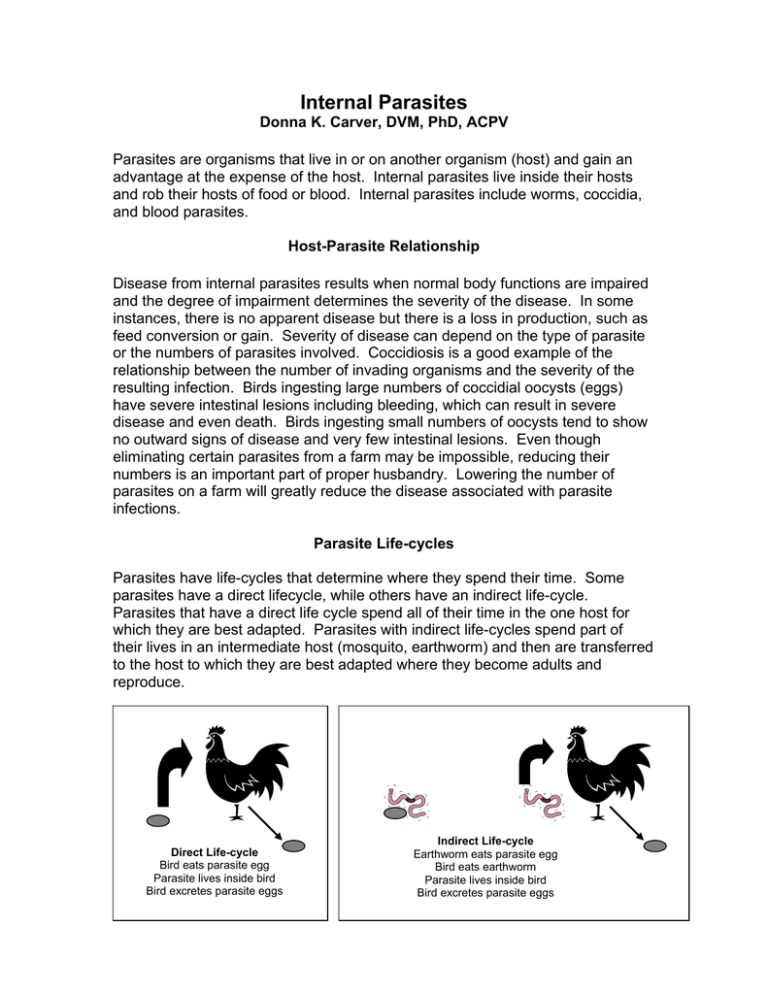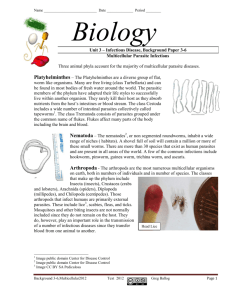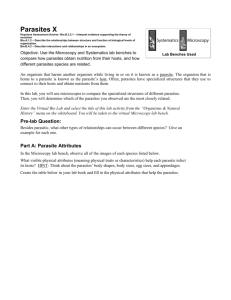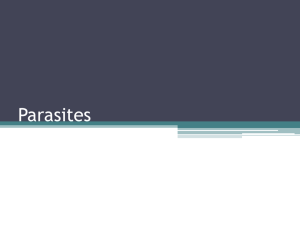Internal Parasites
advertisement

Internal Parasites Donna K. Carver, DVM, PhD, ACPV Parasites are organisms that live in or on another organism (host) and gain an advantage at the expense of the host. Internal parasites live inside their hosts and rob their hosts of food or blood. Internal parasites include worms, coccidia, and blood parasites. Host-Parasite Relationship Disease from internal parasites results when normal body functions are impaired and the degree of impairment determines the severity of the disease. In some instances, there is no apparent disease but there is a loss in production, such as feed conversion or gain. Severity of disease can depend on the type of parasite or the numbers of parasites involved. Coccidiosis is a good example of the relationship between the number of invading organisms and the severity of the resulting infection. Birds ingesting large numbers of coccidial oocysts (eggs) have severe intestinal lesions including bleeding, which can result in severe disease and even death. Birds ingesting small numbers of oocysts tend to show no outward signs of disease and very few intestinal lesions. Even though eliminating certain parasites from a farm may be impossible, reducing their numbers is an important part of proper husbandry. Lowering the number of parasites on a farm will greatly reduce the disease associated with parasite infections. Parasite Life-cycles Parasites have life-cycles that determine where they spend their time. Some parasites have a direct lifecycle, while others have an indirect life-cycle. Parasites that have a direct life cycle spend all of their time in the one host for which they are best adapted. Parasites with indirect life-cycles spend part of their lives in an intermediate host (mosquito, earthworm) and then are transferred to the host to which they are best adapted where they become adults and reproduce. Direct Life-cycle Bird eats parasite egg Parasite lives inside bird Bird excretes parasite eggs Indirect Life-cycle Earthworm eats parasite egg Bird eats earthworm Parasite lives inside bird Bird excretes parasite eggs Internal Parasite Classification Internal parasites can be classified into several types based on their body types, life cycle and damage to their hosts. Internal parasites of poultry include roundworms or Nematodes, tapeworms or Cestodes, flukes or Trematodes, and Protozoa including coccidia, Cryptosporidia, Histomonas species (blackhead), Trichomonas species and other blood and tissue protozoa. Roundworms Roundworms are common in poultry, waterfowl and wild birds. There are numerous species of roundworms and they can cause significant damage to the organ(s) in which they prefer to live. Most roundworms affect the gastrointestinal tract (GI tract), with an occasional parasite affecting the trachea or eye. There are many species of roundworms but generally knowing the specific species affecting your birds is not necessary. Most roundworms share a common trait that helps prevent infections. Roundworms have an indirect lifecycle that utilizes an intermediate host. Targeting the intermediate host is an effective way to break the cycle of future infections. Roundworms can be carried by beetles, cockroaches, earthworms, earwigs, grasshoppers and sowbugs. Reducing birds’ exposure to these intermediate hosts can lower risk of infection. Tapeworms Tapeworms or Cestodes are warm weather parasites. The bodies of the worms are flattened like a piece of tape or ribbon. The parasites are found more commonly in warm weather when intermediate hosts are abundant. Some of the larger tapeworms may appear to completely block the intestine of infected birds while other tapeworms cause little problems for birds. Because the intermediate hosts for tapeworms vary greatly, it is important to have the tapeworm species identified in order to target prevention efforts towards the correct intermediate host. When you get a laboratory diagnosis of tapeworm infection, always ask what intermediate host is involved in the parasite’s lifecycle. Intermediate hosts for tapeworms include ants, beetles, copod crustaceans, freshwater crustaceans, earthworms, grasshoppers, houseflies, leeches, slugs, snails, and stable flies. As with roundworms, controlling the intermediate hosts of tapeworms is important in preventing initial infections and in reducing risk for reinfection. Flukes Flukes or Trematodes are flat leaf-like organisms that that requires a molluscan intermediate host, with some species using a second intermediate host. Adult flukes and larval stages invade almost every cavity and tissue in birds. Those invading the oviduct can cause problems if the parasites are shed into the eggs. As with other parasites controlling the intermediate hosts is important. Intermediate hosts most commonly encountered by poultry include snails, dragonfly naids, mollusks, and wild birds. Keeping birds fenced away from ponds and discouraging visits by wild birds greatly reduce the risk of poultry becoming infected with flukes. Protozoa Protozoa are common in poultry and other birds and can cause mild to severe disease. Because of the complex life-cycle of protozoa, disinfection and quarantine have been of little value in the past. Chemoprevention and chemotherapy are most often used to control protozoal infections in poultry. Vaccination is also used in some instances to control protozoa. Though there are many types of protozoa that affect poultry the most common include: coccidia, Cryptosporidia, Histomonas and Trichomonas. Coccidia are found in nearly all poultry. Coccidia multiply in the intestinal tract and cause tissue damage which interrupts feeding and digestive processes such as nutrient absorption. This can result in dehydration, blood loss, loss of weight, and increased susceptibility to other diseases. Backyard flocks can develop immunity to coccidia if infections are mild. Management of the environment to discourage the viability of oocysts (coccidia eggs) will reduce the infection pressure. Keeping birds in sunny areas that are dry will reduce the oocyst numbers. Most birds receive feed with coccidiostats to keep the organism numbers low in order to reduce tissue damage, while allowing the birds to develop immunity to the protozoa. Histomonas species cause a disorder of the ceca and liver in many birds. This disease is sometimes called “blackhead”. The cecal worm and earthworms are intermediate hosts for histomoniasis (disease caused by Histomonas species). Raising turkeys in an area where chickens have previously or are currently being raised in a risk factor for infection in turkeys. The disease is more severe in turkeys than in chickens, therefore chickens can carry Histomonas species without showing any signs of infection. Turkeys should not be reared with chickens or on range where chickens have been reared during the previous several years. Histomoniasis occurs wherever suitable avian hosts coexist with cecal worms and earthworms. Once again, controlling intermediate hosts is key to preventing histomoniasis. Trichomonas species affect the upper gastrointestinal tract of turkeys, chickens and a wide variety of wild birds. Pigeons in particular are known to transmit trichomoniasis (disease caused by Trichomonas species) to poultry. Affected poultry may stop eating and become listless, ruffled in appearance and emaciated before death. A greenish to yellowish fluid may be seen in the mouth and drip from the beaks of infected birds. Preventing contact between poultry and wild birds will reduce the risk of infection in your poultry flock. Get a Diagnosis Identifying what parasite is present in your birds allows you to make good decisions on treatment and prevention. Prevention is essential in “breaking the cycle” and decreasing your chances for re-infection. Knowing what parasite is present allows you to know which intermediate host to target with your eradication program. Identification of parasites requires a trained parasitologist or veterinarian. Your local small animal veterinarian may be able identify parasite eggs in fecal samples. Your state diagnostic laboratory can also provide identification of parasites. Depending on where you live this may involve a fee and it will also involve sacrificing a bird or two in order to obtain information that can be used to treat the entire flock. Birds submitted should be exhibiting signs of parasitism or disease but if possible should be alive. Veterinarians at the diagnostic lab will humanly kill the birds and perform a necropsy (known as an autopsy in humans) to look for lesions and parasites throughout the body. Once a diagnosis is made, you will be notified of the findings and any parasites present will be identified. You won’t get your birds back but you will get information that will help you treat the rest of the flock. Treatment Prevention of contact with the intermediate host or with infected birds introduced to your flock is the first step to consider in parasite control. It is always advisable to quarantine any new arrivals for at least 30 days before introducing them to your established flock. New birds should be monitored for signs of parasites and other diseases during this 30 day period. If warranted, birds should be treated for parasites before placing them in contact with your flock. Even when chemical agents are required to treat infected birds, controlling the intermediate host is essential in “breaking the cycle” and preventing re-infection. Once an established infection is identified treating birds with chemical agents to kill the parasites in often needed. It is important to combine chemical treatments with prevention strategies targeting intermediate hosts. This combination of approaches is most likely to result in the successful elimination for parasites from your farm. Chemical agents used for roundworms include: Piperazine In feed 0.2-0.4% In water 0.1-0.2% (best if all medicated water consumed within a few hours) As a single treatment of 50-100mg/bird (chicken) As a single treatment of 100 mg/bird in turkeys < 12 weeks of age As a single treatment of 100-400mg/bird in turkeys >12 weeks of age Hygromycin B in feed at a level of 0.00088-0.00132% (3 day withdrawal prior to slaughter) Coumaphos in feed at 0.003-0.004% for 10-14 days repeat treatment in 3 weeks Thiabendazole in feed at 0.05% for 2 weeks (approved for pheasants only) Chemical agents used for tapeworms include: Butynorate in feed 0.0375% (28 days withdrawal prior to slaughter) Chemical agents used for flukes: There are no approved chemical treatments for flukes. Preventing birds’ access to ponds and wild birds can prevent infection or “break the cycle”. Chemical agents used for coccidia: There are numerous products on the market to prevent/treat coccidia. Those approved for use in feed will need to be mixed in by your feed supplier. Some compounds available in various combinations and used in water include: Sulfamethazine 0.1% for 2 days; 0.05% for 4 days (10 day withdrawal prior to slaughter) Amprolium 0.012-0.024 for 3-5 days (no withdrawal time) 0.006% for 1-2 weeks (no withdrawal time) Sulfachloropyrazine monohydrate 0.03% for 3 days (4 day withdrawal prior to slaughter) Sulfadimethoxine 0.05% for 6 days (5 day withdrawal prior to slaughter) Chemical agents used for Histomonas species: Nitarsone in feed at 0.0187% (5 day withdrawal of drug prior to slaughter) Chemical agents used for Trichomonas species: There are no approved effective chemicals for treatment of trichomoniasis. Prevention involves removal of carrier birds, separation of older stock from poults and chicks, and thorough cleaning of areas around feeders and waterers. Conclusions Some parasitic infections can be prevented and some cannot. Providing your flock with range that is sunny and well drained will greatly reduce your risk of infection. Targeting intermediate hosts such as snails, worms and insects can “break the cycle” and result in decrease risk of infection. Keeping the areas around feeders and waterers clean and dry will also reduce the numbers of parasite eggs available to be ingested by your birds. Parasite eggs do not tolerate sunlight and dry conditions well. Many intermediate hosts are also adversely affected by sunlight and dry conditions. Use that to your advantage. If you suspect that you have a parasite problem due to birds not gaining weight, not eating, looking ruffled or dying, get help from a professional. Identification of the parasite can save you money by allowing you to target your eradication efforts on known intermediate hosts. Guesswork and multiple attempts to “break the cycle” will cost more money and time and may ultimately cost the birds their lives. Remember, always separate new birds for 30 days before placing them with your flock, because they may be introducing parasites onto your farm that you may not be able to eradicate.






